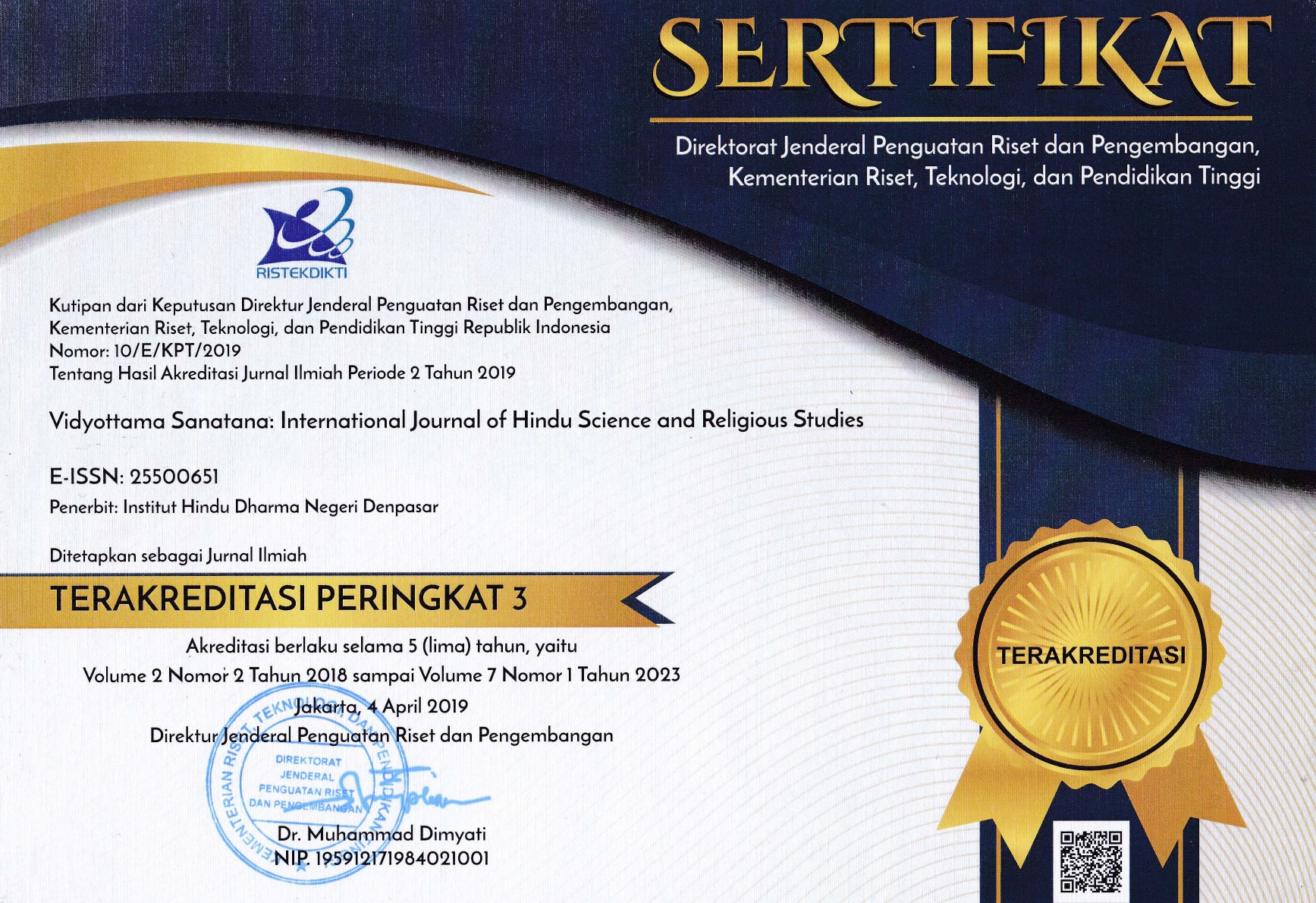THE FUNCTION OF THE TOLOTANG TRADITIONAL LEADER'S HOUSE AS A MEDIA FOR CONFLICT RESOLUTION IN THE HINDU COMMUNITY IN AMPARITA VILLAGE
DOI:
https://doi.org/10.25078/vidyottama.v7i2.2379Abstract
The Tolotang Hindu community in Amparita Village is a traditional community whose life is still dominated by old customs. The majority of residents in Amparita Village adhere to Hinduism as a core belief from time to time until now. All lines of activities related to customs, traditions and religion are implemented and decided at the Tolotang Traditional Leader's house. The House of Tolotang Traditional Figures is one of the traditional traditional houses of the Bugis community as the residence of Tolotang Traditional Figures. Apart from being a place for traditional leaders and their families to live, this house also has another function as a place to resolve disputes or social conflicts that occur in society.The approach used in this study is a qualitative approach. The data sources used are primary data in the form of data obtained from observations, interviews and documentation, and secondary data in the form of relevant data related to the research. Determining informants using purposive sampling technique. Data analysis techniques include data reduction, data classification, data interpretation, and drawing conclusions. The theories used to dissect existing problems are structural functionalism theory, conflict resolution theory, and social integration theory.The function of the Tolotang Traditional Leader's house is as a media for resolution, namely conflict as a function as a medium for discussion, as a medium for negotiations, as a place of mediation, as a place of mediation, as a function to decide and resolve conflicts, and finally, as a function of protecting the community regarding all problems and issues that exist in the Tolotang community, both related to ceremonial activities. religion, traditions and customs as well as resolving social conflicts that occur in society. The conflict resolution process carried out at the Tolotang Traditional Leader's house consists of several stages or parts, namely starting with conflict analysis or problem analysis, deliberation involving both parties to unite their voices or opinions, after the deliberation process to reach a consensus, the process of taking action must be in accordance with the method or the path to resolving the conflict that has been determined, then building a joint agreement to implement the results of the decision, and finally the decision evaluation stage so that it can represent all the interests of the conflicting parties and provide a sense of fairness to all parties.
References
Andriani Jamaluddin, dkk. (2017). Karakteristik Arsitektut Rumah Bugis Tolotang di Amparita, kabupaten Sidenreng-Rappang. Dalam prosiding temu ilmiah 2017. Fakultas Teknik Universitas Hasanuddin Makassar. (online) https://temuilmiah.iplbi.or.id/wp-content/uploads/2017/12/ti6i001.pdf. Downloaded on May 15, 2021.
Anggono, Toha. (2011). Materi Pokok Metode Penelitian. Jakarta: Universitas Terbuka
Arikunto, Suharsini. (2002). Prosedur Penelitian Suatu Pendekatan Praktek. Jakarta: Bimas Angkasa.
Aris Alimuddin. "Kebudayaan dan Sinkretisme Terhadap Pembentukan Ruang Serta Bentuk Rumah Tradisional Tolotang Kabupaten Sidrap". E-jurnal volume
nomor 2 tahun 2016. Universitas Muslim Indonesia Makassar. (online) http://jurnal.ft.umi.ac.id/index.php/lo sari/article/view/43. Di unduh 17 Mei 2021.
Bagus, Lorens. (2005). Kamus Filsafat. Jakarta: Gramedia
Basrowi dan Suwandi. (2008). Memahami Penelitian Kualitatif. Jakarta: Rineka Cipta.
Budiono, M.A. (2005). Kamus Lengkap Bahasa Indonesia. Surabaya: Karya Agung.
Chang, William.(2021). Manajemen Konflik Analisis Etika Sosial. Kompas Media
Nusantara: Jakarta.
Darmapoetra, Juma. (2014). Suku Bugis Pewaris Keberanian Leluhur. Makassar: Arus Timur.
Hasan, Iqbal.(2002). Metode Penelitian dan Aplikasinya. Jakarta: Ghalia Indonesia.
Kristanto, Andri.(2020). Manajemen Konflik. Yogyakarta: Gava Media Koentjaraningrat.(2000). Pengantar Ilmu Antropologi. Jakarta: Rineka Cipta.
Malik, Ichsan.(2017). Resolusi Konflik Jembatan Perdamaian. Jakarta: Kompas Media Nusantara
Mattulada, A.(2015). Latoa Antropologi Politik Orang Bugis. Yogjakarta. Ombak.
Mulyana, Dedi.(2001). Metode Penelitian Kualitatif, Paradigma Baru Ilmu Komunikasi dan Ilmu Sosial Lainnya. Bandung: Remaja Rosdakarya.
Moleong, Lexy J. (2010). Metodologi Penelitian Kualitatif (EdisiRevisi). Cetakan Kedua Puluh Delapan. Bandung: Rosdakarya.
Nawawi, H. Hadari. (2005). Metode Penelitian Sosial. Yogyakarta: Gadjah Mada Universitas Press.
Pelras, Christian.(2006). Manusia Bugis. Jakarta: Nalar
Ratna, Nyoman kutha. (2010). Teori, Metode, dan Tekhnik Penelitian Sastra. Yogyakarta: Pustaka Pelajar.
Semi, Atar. (2012). Metode Penelitian Sastra. Edisi Revisi. Bandung: Angkasa.
Sugiyono.(2012). Metode Penelitian Kombinasi (Mixed Methods). Cetakan Kedua. Bandung: Alfabeta.
Sugono, Dendy.(2008). Kamus Besar Bahasa Indonesia Pusat Bahasa. Jakarta: Gramedia Pustaka Utama.
Sulistyawati, Anastasia.(2017). Transformasi Unit-unit Bangunan Simbolik Stana Manifestasi Ida Sang Hyang Widhi Wasa Pada Pekarangan Sikut Satak Di Desa Wisata Ubud Bali. Disertasi: IHDN Denpasar.
Suprayoga, Imam. 2003. Metodelogi Penelitian Sosial-Agama. Bandung: Remaja Roesdakarya.
Wendra, I Wayan. 2009. Buku Ajar Penulisan Karya Ilmiah. Undiksa: Singaraja. Wirawan, 2015. Teori- Teori Sosial dalam tiga Paradigma. Jakarta. Prenadamedia
Goup.


















